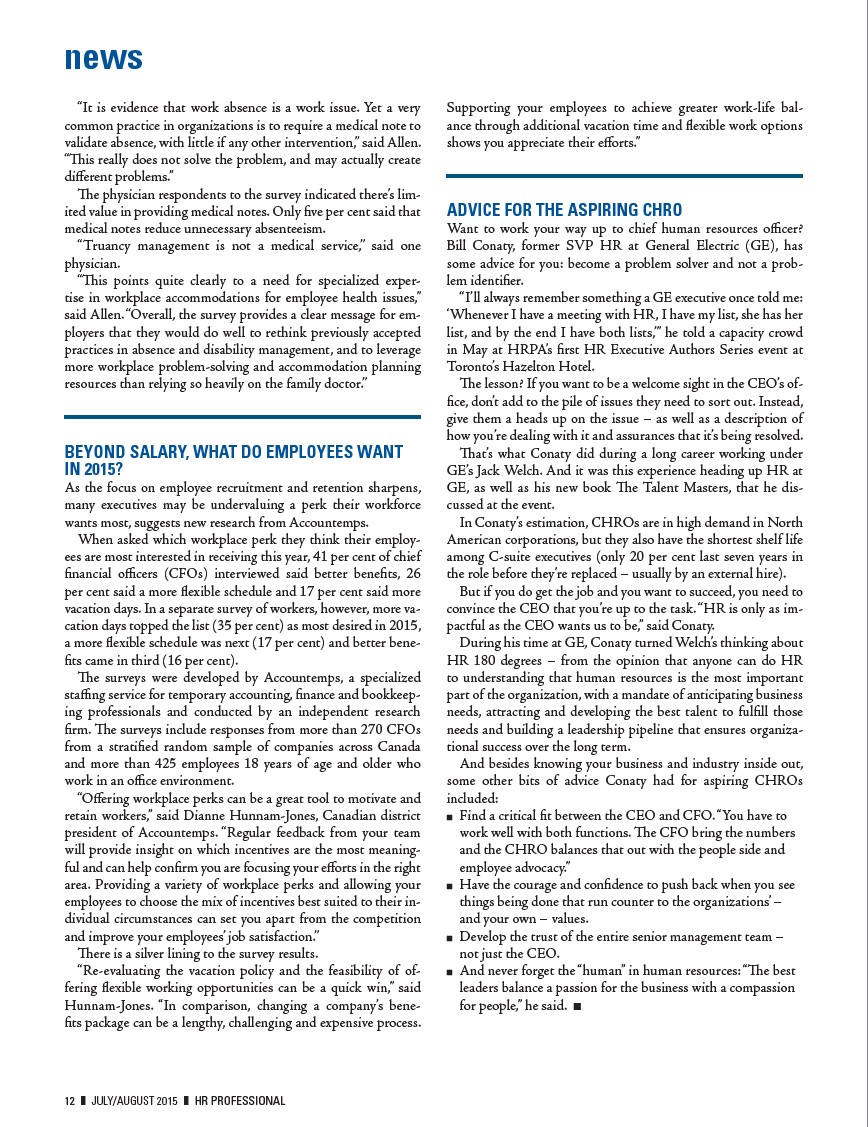
news
“It is evidence that work absence is a work issue. Yet a very
common practice in organizations is to require a medical note to
validate absence, with little if any other intervention,” said Allen.
“This really does not solve the problem, and may actually create
different problems.”
The physician respondents to the survey indicated there’s limited
value in providing medical notes. Only five per cent said that
medical notes reduce unnecessary absenteeism.
“Truancy management is not a medical service,” said one
physician.
“This points quite clearly to a need for specialized expertise
in workplace accommodations for employee health issues,”
said Allen. “Overall, the survey provides a clear message for employers
that they would do well to rethink previously accepted
practices in absence and disability management, and to leverage
more workplace problem-solving and accommodation planning
resources than relying so heavily on the family doctor.”
BEYOND SALARY, WHAT DO EMPLOYEES WANT
IN 2015?
As the focus on employee recruitment and retention sharpens,
many executives may be undervaluing a perk their workforce
wants most, suggests new research from Accountemps.
When asked which workplace perk they think their employees
are most interested in receiving this year, 41 per cent of chief
financial officers (CFOs) interviewed said better benefits, 26
per cent said a more flexible schedule and 17 per cent said more
vacation days. In a separate survey of workers, however, more vacation
days topped the list (35 per cent) as most desired in 2015,
a more flexible schedule was next (17 per cent) and better benefits
came in third (16 per cent).
The surveys were developed by Accountemps, a specialized
staffing service for temporary accounting, finance and bookkeeping
professionals and conducted by an independent research
firm. The surveys include responses from more than 270 CFOs
from a stratified random sample of companies across Canada
and more than 425 employees 18 years of age and older who
work in an office environment.
“Offering workplace perks can be a great tool to motivate and
retain workers,” said Dianne Hunnam-Jones, Canadian district
president of Accountemps. “Regular feedback from your team
will provide insight on which incentives are the most meaningful
and can help confirm you are focusing your efforts in the right
area. Providing a variety of workplace perks and allowing your
employees to choose the mix of incentives best suited to their individual
circumstances can set you apart from the competition
and improve your employees’ job satisfaction.”
There is a silver lining to the survey results.
“Re-evaluating the vacation policy and the feasibility of offering
flexible working opportunities can be a quick win,” said
Hunnam-Jones. “In comparison, changing a company’s benefits
package can be a lengthy, challenging and expensive process.
Supporting your employees to achieve greater work-life balance
through additional vacation time and flexible work options
shows you appreciate their efforts.”
ADVICE FOR THE ASPIRING CHRO
Want to work your way up to chief human resources officer?
Bill Conaty, former SVP HR at General Electric (GE), has
some advice for you: become a problem solver and not a problem
identifier.
“I’ll always remember something a GE executive once told me:
‘Whenever I have a meeting with HR, I have my list, she has her
list, and by the end I have both lists,’” he told a capacity crowd
in May at HRPA’s first HR Executive Authors Series event at
Toronto’s Hazelton Hotel.
The lesson? If you want to be a welcome sight in the CEO’s office,
don’t add to the pile of issues they need to sort out. Instead,
give them a heads up on the issue – as well as a description of
how you’re dealing with it and assurances that it’s being resolved.
That’s what Conaty did during a long career working under
GE’s Jack Welch. And it was this experience heading up HR at
GE, as well as his new book The Talent Masters, that he discussed
at the event.
In Conaty’s estimation, CHROs are in high demand in North
American corporations, but they also have the shortest shelf life
among C-suite executives (only 20 per cent last seven years in
the role before they’re replaced – usually by an external hire).
But if you do get the job and you want to succeed, you need to
convince the CEO that you’re up to the task. “HR is only as impactful
as the CEO wants us to be,” said Conaty.
During his time at GE, Conaty turned Welch’s thinking about
HR 180 degrees – from the opinion that anyone can do HR
to understanding that human resources is the most important
part of the organization, with a mandate of anticipating business
needs, attracting and developing the best talent to fulfill those
needs and building a leadership pipeline that ensures organizational
success over the long term.
And besides knowing your business and industry inside out,
some other bits of advice Conaty had for aspiring CHROs
included:
■■ Find a critical fit between the CEO and CFO. “You have to
work well with both functions. The CFO bring the numbers
and the CHRO balances that out with the people side and
employee advocacy.”
■■ Have the courage and confidence to push back when you see
things being done that run counter to the organizations’ –
and your own – values.
■■ Develop the trust of the entire senior management team –
not just the CEO.
■■ And never forget the “human” in human resources: “The best
leaders balance a passion for the business with a compassion
for people,” he said. n
12 ❚ JULY/AUGUST 2015 ❚ HR PROFESSIONAL